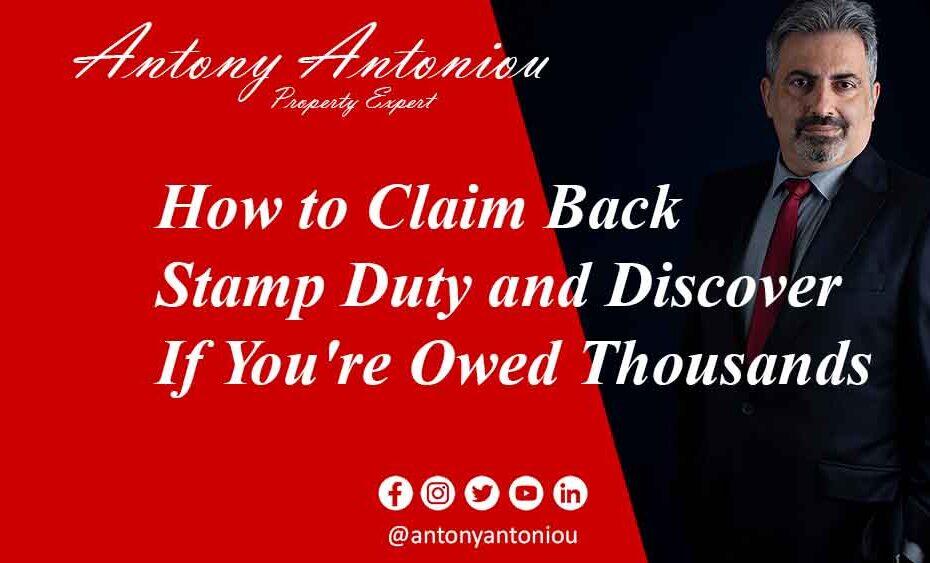How to Claim Back Stamp Duty and Discover If You’re Owed Thousands
A guide to requesting a refund for Stamp Duty that you have paid
Are you a homeowner in the UK, considering the purchase of a second property? If so, you may be aware that along with the excitement of owning another home, there comes a financial burden in the form of stamp duty. However, what you might not know is that there are legitimate ways to potentially claim back thousands of pounds in stamp duty. In this guide, we’ll walk you through everything you need to know about the stamp duty surcharge, when you can claim a refund, and how to go about it.
Understanding the Stamp Duty Surcharge
When purchasing a second property, whether it’s a buy-to-let investment or a holiday home, you’re subject to an additional 3% surcharge on top of the regular stamp duty. This surcharge was introduced in April 2016 to discourage multiple property ownership and applies in England and Northern Ireland. Scotland and Wales also have similar surcharge rates under their devolved tax systems.
For instance, if you buy a second property valued between £250,000 and £925,000, you’ll pay a stamp duty rate of 8% (5% standard plus 3% surcharge). On a property between £925,000 and £1.5 million, the stamp duty rate will be 13% (10% standard plus 3% surcharge). If you’ve paid this surcharge and meet certain conditions, you could be entitled to a refund worth thousands of pounds.
Eligibility for an HMRC Stamp Duty Refund
The good news is that you might be eligible for a refund of the stamp duty surcharge if you decide to sell your main residence. This situation often arises when individuals purchase a new home but don’t immediately sell their previous one due to various reasons, such as renovation work or the complexities of divorce proceedings.
To qualify for a refund, the sale of your primary residence must occur within three years of completing the purchase of your second property or buy-to-let investment. This refund, known as the “three-year rule,” applies when one main residence is replaced with another. It does not apply if you sell a rental property to fund your new home.
In some cases, you may be able to apply for a refund beyond the three-year limit if you purchased your new home on or after January 1, 2017, and were unable to sell your previous residence within three years due to circumstances beyond your control, such as the COVID-19 pandemic or actions taken by a public authority to prevent the sale.
Once your primary residence is sold, you can apply for the refund by writing to HM Revenue and Customs (HMRC) and providing the necessary information for a stamp duty refund. HMRC will assess your eligibility and process your request.
How to Apply for a Stamp Duty Refund
Claiming a stamp duty refund is a straightforward process that you can handle yourself for free. To do this, you’ll need to complete a stamp duty land tax return, which can be done online through the Government website using your Government Gateway user ID and password. Alternatively, you can print the form and send it to HMRC by post.
Gather all the required information before starting the process, including details of the property for which you paid the higher rate of stamp duty (purchase date and stamp duty transaction reference number) and information about the property you’ve sold (sale date, property address, and the buyer’s name). You’ll also need to specify the refund amount and provide your bank details for payment.
If you’re already working with a solicitor for your property transaction, you can ask them to handle the stamp duty refund paperwork as well. However, be aware that this might come with an additional fee, so it’s essential to understand the charges involved.
It’s worth noting that there are third-party firms that offer to make stamp duty refund claims on your behalf, but their fees can be high, so carefully consider this option.
Timing and Expectations for Receiving Your Refund
Once you’ve submitted your refund request with all the required documentation, you should technically receive your refund in approximately 15 days. However, in practice, it might take a bit longer due to delays that can occur within HMRC’s processing system.
Nicholas Christofi, managing director of Sirius Property Finance, suggests that while it could take up to six months, a more realistic estimate is around two months. Be prepared for some waiting time, but the potential financial gain makes the process well worth it.
In conclusion, if you’ve paid the stamp duty surcharge when purchasing a second property in the UK and meet the eligibility criteria, don’t miss out on the opportunity to claim a refund worth thousands. By understanding the rules, gathering the necessary information, and following the straightforward application process, you can recoup the extra money you’ve paid in stamp duty and enjoy a more rewarding homeownership experience.

